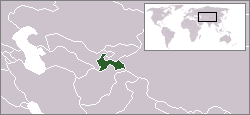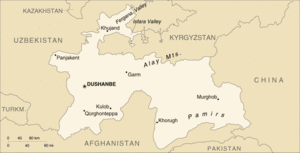Tajikistan
|
|
| |||||

| |||||
| National anthem | Surudi milli | ||||
| Official language | Tajiki-Persian | ||||
| Capital | Dushanbe | ||||
| President | Emomali Rahmonov | ||||
| Prime Minister | Akil Akilov | ||||
| Area – Total – % water | Ranked 92nd 143,100 km² 0.3% | ||||
| Population – Total (2003) – Density | Ranked 95th 6,863,752 48/km² | ||||
| Independence – Date | From Soviet Union September 9, 1991 | ||||
| Currency | Tajikistani Somoni | ||||
| Time zone | UTC +5 | ||||
| Calling Code | 992 | ||||
| Internet TLD | .tj | ||||
The Republic of Tajikistan (Тоҷикистон), formerly known as the Tajik Soviet Socialist Republic, is a country in Central Asia. It has borders with Afghanistan, China, Kyrgyzstan, and Uzbekistan. Tajikistan means the 'Land of the Tajiks'.
| Contents |
History
Main article: History of Tajikistan
Humans have been permanently installed in the land that is now Tajikistan since 4,000 BC. The land has been under the rule of various empires throughout history, mostly the Persian Empire. Before AD, it was part of the Bactrian Empire. Arabs brought Islam in the 7th century. The Samanid Empire supplanted the Arabs but was eventually superseded by Turkic invaders. The Mongols would later take control of the area, and Tajikistan would become a part of the emirate of Bukhara.
In the 19th century, the Russian Empire began to expand, and spread into Central Asia. During the Great Game, it came in control of Tajikistan. After the overthrow of the Tsar in 1917, Tajik guerillas waged a war against Bolshevik armies in a futile attempt to maintain independence. The Bolsheviks would prevail after a four year war, in which mosques and villages were burned down and the population heavily suppressed.
As part of the Soviet Union, Tajikistan was initially grouped with what is now Uzbekistan in the Autonomous SSR of Tajikistan, but was later made a separate constituent republic. Moscow did not do much to develop the Tajik SSR, and it remained relatively behind other Soviet Republics in living conditions, education and industry. In the 1970s Islamic underground parties began to form, and served to rally Tajiks against the USSR, but real disturbances did not occur until 1990. The following year, the USSR collapsed, and Tajikistan declared its independence.
The nation almost immediately fell into a civil war that involved various factions fighting one another, these factions were often distinguished by tribal loyalties. Emomali Rahmonov was the first leader of the nation, and continues to rule to this day. However, he has been accused of ethnic cleansing against other ethnicities and groups during the Tajikistan Civil War. In 1997 a cease-fire was reached between Rahmonov and opposition parties (United Tajik Opposition). Peaceful elections were held in 1999, but they were reported by the opposition as unfair, and Rahmonov was re-elected by almost unanimous vote. Russian troops continue to be stationed in southern Tajikistan, in order to guard the border with Afghanistan. Since the September 11th Attacks, American troops have also been stationed in the country.
Politics
Main article: Politics of Tajikistan
Almost immediately after independence, Tajikistan was plunged into a civil war that saw various factions, allegedly backed by Russia and Iran, fighting one another. All but 25,000 of the more than 400,000 ethnic Russian middle-management middle class fled to Russia. By 1997 the war had cooled down, and a central government began to take form.
Tajikistan is officially a republic, and holds elections for the President and Parliament. The latest elections occurred in 2005, and as all previous elections, international observers believe them to have been flawed, arrousing many accusations from opposition parties that President Emomali Rakhmonov intervenes with the election process.
In the Parliament, opposition groups have often clashed with the ruling party, but this has not led to great instability.
- Account of events from independence leading to the Bishkek agreement of 1997 (http://www.oneworld.org/ips2/may/tajik.html)
Provinces
Main article: Provinces of Tajikistan
Tajikistan is divided into regions, or provinces (singular: viloyat, plural: viloyatho) (capitals in parentheses)-
- Khatlon Viloyati Khatlon (Qurghonteppa)
- Sughd Viloyati Sughd (Khujand)
- Karotegin (Kofarnihon)
and one autonomous province (viloyati mukhtor)-
- Gorno-Badakhshan Autonomous Region (GBAR) Viloyati Mukhtori Kuhistoni Badakhshon (Khorugh).
Additionally, the area containing the capital (RRS, Region of Republican Subordination), Dushanbe, has no viloyat-level administrative divisions.
note: the administrative center name follows in parentheses
Geography
Main article: Geography of Tajikistan
Tajikistan is landlocked, and is the smallest nation in Central Asia by area. It is covered by mountains of the Pamir range, and more than fifty percent of the country is 3,000 meters (approx. 10,000 feet) above sea level. The Amu-Darya and Pyanj rivers mark the border with Afghanistan.
Economy
Main article: Economy of Tajikistan
Tajikistan is the poorest country of the ex-USSR and one of the poorest countries in the world. With foreign revenue precariously dependent upon exports of cotton and aluminum, the economy is highly vulnerable to external shocks. In FY 2000, international assistance remained an essential source of support for rehabilitation programs that reintegrated former civil war combatants into the civilian economy, thus helping keep the peace. International assistance also was necessary to address the second year of severe drought that resulted in a continued shortfall of food production. On August 21st 2001, the Red Cross announced that a famine was striking Tajikistan, and called for international aid for Tajikistan and Uzbekistan.
Demographics
Main article: Demographics of Tajikistan
Tajikistan has a population of 7,011,556 (July 2004). The major ethnic group is the Tajik, although there is a sizeable minority of Uzbeks, and a small population of Russians, whose numbers are declining due to emigration. Pamiris of Badakhshan are considered to belong to larger group of Tajiks. Likewise, the official language of Tajikistan is Tajik, while Russian is largely spoken in business and for government purposes. Although the Tajik and Uzbek are now classified as separate ethnic groups, on account of their languages, this is a relatively new phenomenon and originates from the conquest of Central Asia by the Russian Empire in the 19th century. Despite its poverty, Tajikistan has a high rate of literacy with an estimated 98% of the population having the ability to read and write. Most of the population follows Sunni Islam, although a sizeable number of Shia are present as well.
Culture
Main article: Culture of Tajikistan
The culture of Tajikistan was originally shared with that of Uzbekistan, but during Communist rule, the cultural fabric of the region was disrupted by the Soviet leadership imposing artificial boundaries and the notion of nation-state - alien to the region - on the area. This has not been completely detrimental though, as Tajikistan was known for its theater and famous novelists during the Soviet era. Among these writers were individuals who strove to purify the Tajik language by tying it in more with Persian and eliminating Arabic loanwords.
Most citizens of Tajikistan are Muslim. The impact of Islam has grown in recent years, and was a strong bonding force during Tajikistan's fight against Soviet rule and during its civil war. Historically, a lot of Tajik culture ties it to the Persian past of the region, and Persian writers, scientists and poets such as Ibn Sina, Firdausi, Rudaki, and Omar Khayyam are especially revered.
Miscellaneous topics
- Communications in Tajikistan
- Transportation in Tajikistan
- Military of Tajikistan
- Foreign relations of Tajikistan
Democracy
- "We have to wait a little bit, and the nation will rebel itself" (http://www.thinking-east.net/site/index.php?option=com_content&task=view&id=93) by Daler Rahimov
- Tajik elections need international support (http://www.thinking-east.net/site/index.php?option=com_content&task=view&id=78&Itemid=56) by Daler Rahimov
Culture
- The Mosque and State in Tajikistan (http://www.thinking-east.net/site/index.php?option=com_content&task=view&id=55&Itemid=56) by Daler Rahimov
External links and references
- Text in the sub-articles from the CIA World Factbook, 2000 and 2003
- Tajikistan general portal site (http://tajikistan.tajnet.com/)
- Khovar (http://www.khovar.tj/) Tajikistan news agency.
- Tajik Development Gateway (http://www.tajik-gateway.org/)
| Countries in Central Asia |
|---|
|
China (PRC) | Kazakhstan | Kyrgyzstan | Mongolia | Russia | Tajikistan | Turkmenistan | Uzbekistan |
| Commonwealth of Independent States (CIS) | 
|
| Armenia | Azerbaijan | Belarus | Georgia | Kazakhstan | Kyrgyzstan | Moldova | Russia | Tajikistan | Turkmenistan | Ukraine | Uzbekistan | |

